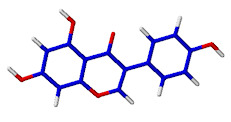What are isoflavones?
 Isoflavones are phytochemicals, i.e. compounds found only in plants. They are a type of phytoestrogen because they resemble human estrogen in chemical structure, but their biological action is much weaker. By mimicking human estrogen at specific sites in the body, isoflavones provide many health benefits that help prevent disease. By blocking estrogen receptors, they can act as anti-estrogens, but they can also act as weak estrogens. Isoflavones are found in soybeans, chickpeas, and some other legumes. However, soybeans are unique in that they contain the highest concentration of these powerful compounds. The main isoflavones found in soy are genistein and daidzein.
Isoflavones are phytochemicals, i.e. compounds found only in plants. They are a type of phytoestrogen because they resemble human estrogen in chemical structure, but their biological action is much weaker. By mimicking human estrogen at specific sites in the body, isoflavones provide many health benefits that help prevent disease. By blocking estrogen receptors, they can act as anti-estrogens, but they can also act as weak estrogens. Isoflavones are found in soybeans, chickpeas, and some other legumes. However, soybeans are unique in that they contain the highest concentration of these powerful compounds. The main isoflavones found in soy are genistein and daidzein.
Health effects of isoflavones
Lower cancer risk - Epidemiologic studies have suggested that Asian diets may provide protection against several cancers, including breast, prostate, and colon. The action of isoflavones as weak estrogens allows them to bind to estrogen receptors and block some of the harmful effects of estrogen - such as the promotion of cancer cell growth. Tamoxifen, a prescription drug used to treat breast cancer, is said to act as an anti-estrogen by binding to the estrogen receptor and "blocking" the growth-promoting effects of estrogen in cancer cells. Women using tamoxifen have a lower incidence of breast cancer and a 30-40% reduction in the growth rate of breast cancer cells. The isoflavones in soy are chemically similar to tamoxifen and therefore may also reduce the risk of hormone-dependent cancers via the same "estrogen-blocking" mechanism.Improved bone health - Isoflavone consumption has been shown to reduce bone loss and slow calcium loss in an animal model of osteoporosis, suggesting a possible beneficial role in the prevention of osteoporosis in humans. In addition, soybeans have a relatively high calcium content. It is also interesting to note that soy protein appears to cause less loss of calcium from the body than other dietary protein sources, which at high levels can promote calcium loss and bone breakdown. Ipriflavone, a synthetic isoflavone drug prescribed in Europe, is metabolized in the body to daidzein and has potent effects on reducing bone resorption in postmenopausal women.
Eases menopausal symptoms - Soy foods containing isoflavones may help in the treatment of menopausal symptoms. In women who produce little estrogen, phytoestrogens may produce enough estrogenic activity to relieve symptoms such as hot flushes. From an epidemiological point of view, it is interesting that in Japan, where soy consumption is very high, menopausal symptoms of any kind are rarely reported.
Lowers cholesterol - Isoflavones have antioxidant activity and not only help to reduce bad LDL cholesterol, but also increase good HDL cholesterol.
Isoflavones in soy
Soy contains many isoflavones, but the most beneficial are genistein and daidzein (see structure at right). The soybean contains about 200 mg of isoflavones per 100 g. Other plants contain much less isoflavones.Isoflavone content in some foods (per 100 g):
| Tempeh | 43.52 | mg |
| Peas | 2.42 | mg |
| Peanuts | 0.26 | mg |
| Navy bean | 0.20 | mg |
| Chickpeas | 0.10 | mg |
| Lentils | 0.10 | mg |
| Bread | 0.02 | mg |
| Black bean | 0.00 | mg |

